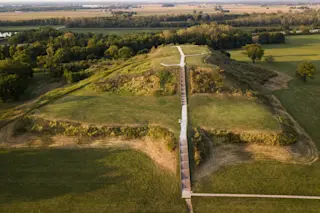One morning in the spring of 2013, the usual crowd of picnickers and fishermen at Horseshoe Lake State Park in Pontoon Beach, Illinois were joined by a small group of scientists. Recreationists looked on as four fleece-clad geochemists loaded equipment into two small inflatable boats and ambled their way into the middle of the lake using wooden canoe paddles. At the helm was then University of Pittsburgh PhD candidate David Pompeani.
This was Pompeani’s second visit to Horseshoe Lake in two years. During the previous field season, he and fellow University of Pittsburgh graduate students had extracted a column of sediment from the lake bed. Analysis revealed that the deepest part of their sample dated back to roughly the 14th century. “I realized we were just short of the sediments that had been deposited during Cahokia,” Pompeani says. “We had to get a deeper core.”
In 2013, Pompeani came prepared ...















